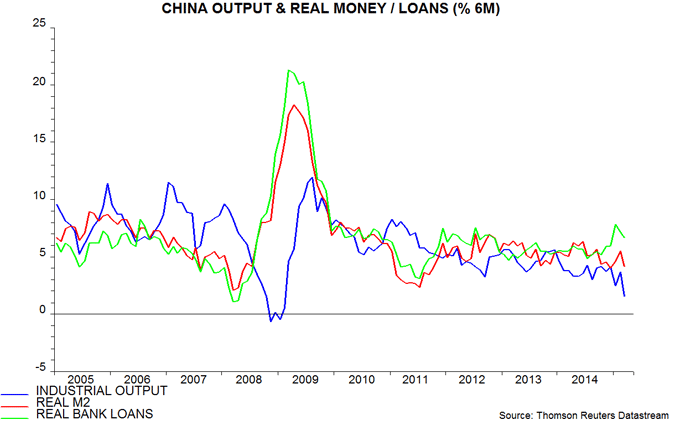Chinese money / lending trends signalling moderate growth
The Chinese economy slowed sharply in early 2015 but money / lending trends are consistent with moderate economic expansion over coming months. Further policy easing, nevertheless, is likely.
Annual growth of real GDP was 7.0% in the first quarter, down from 7.3% in the fourth quarter of 2014 but in line with the 2015 target. This result, however, is difficult to reconcile with much weaker nominal (i.e. current price) data: annual nominal GDP growth fell from 7.7% to 5.8% between the two quarters.
The preferred growth measure here is the six-month change in industrial output*. This slumped to 1.5% in March, or 3.1% annualised – the lowest since 2009.
The Chinese New Year holiday occurred later than usual in 2015, which may have resulted in production being shifted from March to February. Combining the two months, however, six-month output growth was still only 2.6%, or 5.3% annualised.
The recent economic slowdown was signalled by weaker monetary trends in late 2014. Six-month growth of real M2 fell to a 39-month low in December – see chart. It has, however, stabilised in early 2015. The fall in output growth appears exaggerated relative to the current level of real M2 expansion, suggesting some recovery.
Growth of real bank lending, meanwhile, has picked up since late 2014. The normal approach here is to regard credit as a coincident or lagging indicator of economic activity but, in China’s case, it appears to lead. This may reflect the importance of supply shifts in driving credit changes in China, with such shifts often related to policy measures designed to boost or restrain economic growth. In the major developed economies, by contrast, credit demand is typically a stronger influence on lending fluctuations than supply changes. Credit demand depends partly on current economic trends, explaining the coincident / lagging relationship.
Six-month growth of real bank lending slipped back in March but remains above its average in recent years. Medium- and longer-term loans for infrastructure investment and real estate have led recent strength, consistent with official initiatives to boost these areas. Admittedly, overall credit – as measured by “total social financing” – is growing more slowly than bank lending, reflecting weakness in “shadow banking” (i.e. trust loans, entrusted loans and bankers’ acceptances) . Such shadow activities, however, may have less direct implication for economic trends than bank lending. In any case, six-month growth of real total credit, like M2, has moved sideways since end-2014
Today’s weak economic news is likely to result in further policy easing, despite concerns about a bubbly stock market. Together with reassuring money and credit trends, this suggests improving second-half economic prospects, when China should also benefit from stronger global demand – see previous post.
*World Bank seasonally-adjusted level series updated using annual growth data.

Reader Comments